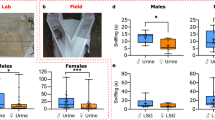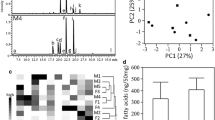Abstract
In one study, using a habituation procedure, male South American cavies,Cavia aperea, distinguished individual differences in odors collected from three sources: perineal gland secretions, urine, and supracaudal gland secretions. In a second study, male cavies spent more noninvestigatory time and rested more on the side of a cage containing the odor of a familiar subordinate male as compared to the cage side containing the odor of a familiar dominant male. Since the odor source was a glass plate which had been left in the home cage of the donor males for three days, the actual odorous cue to which the test males responded is not known. These studies demonstrate that male cavies distinguish odors of individuals, that individual differences in odors are found in at least three different sources, and that cavies use chemical cues to distinguish between known individuals.
Similar content being viewed by others
References
Beauchamp, G.K. 1973. Attraction of male guinea pigs to conspecific urine.Physiol. Behav. 10:589–594.
Beauchamp, G.K. 1976. Diet influences attractiveness of urine.Nature 263:587–588.
Beauchamp, G.K., andBerüter, J. 1973. Source and stability of attractive components in guinea pig (Cavia porcellus) urine.Behav. Biol. 9:43–47.
Beauchamp, G.K., Criss, B., andWellington, J.L. 1979. Chemical communication inCavia: Responses of wild (C. aperea), domestic (C. porcellus) and F1 males to urine.Anim. Behav. 27:1066–1072.
Beer, C.K., 1970. Individual recognition of voice in the social behavior of birds, pp. 27–74,in D.S. Lehrman, R.H. Hinde, and E. Shaw (eds.). Advances in the Study of Behavior. Academic Press, New York.
Berüter, J., Beauchamp, G.K., andMuetterties, E.L. 1974. Mammalian chemical communication: Perineal gland secretion of the guinea pig.Physiol. Zool. 47:130–136.
Bowers, J.M., andAlexander, B.K. 1967. Individual recognition by olfactory cues.Science 158:1208–1210.
Bronson, G.W. 1968. The fear of novelty.Psychol. Bull. 69:350–358.
Brown, R.E. 1979. Mammalian social odors: A critical review, pp. 104–162,in J.S. Rosenblatt, R.A. Hinde, C. Beer, and M.-C. Busnel (eds.). Advances in the Study of Behavior, Vol. 10. Academic Press, New York.
Carr, W.J., Martorano, R.D., andKrames, L. 1970. Responses of mice to odors associated with stress.J. Comp. Physiol. Psychol. 71:223–228.
Dagg, A.I., andWindsor, D.E. 1971. Olfactory discrimination limits in gerbils.Can. J. Zool. 49:283–285.
Epple, G. 1973. The role of pheromones in the social communication of marmoset monkeys (Callithricidae).J. Reprod. Fert. Suppl. 19:447–454.
Goodrich, B.S., andMykytowycz, R. 1972. Individual and sex differences in the chemical composition of pheromone-like substances from skin glands of the rabbit,Oryctolagus cuniculus.J. Mammal. 53:540–548.
Halpin, Z.T. 1974. Individual differences in the biological odors of the Mongolian gerbil (Meriones unguiculatus).Behav. Biol. 11:253–259.
Halpin, Z.T. 1976. The role of individual recognition by odors in the social interaction of the Mongolian gerbil (Meriones unguiculatus).Behaviour 58:117–130.
Johnson, R.P. 1973. Scent marking in mammals.Anim. Behav. 21:521–535.
Krames, L. 1970. Responses of female rats to the individual body odors of male rats.Psychon. Sci. 20:274–275.
Lombardi, J.R., andVandenbergh, J.G. 1977. Pheromonally induced sexual maturation in females: Regulation by the social environment of the male.Science 196:545–546.
Marler, P.R. 1965. Communications in monkeys and apes, pp. 544–584,in I. DeVore (ed.). Primate Behavior: Field Studies of Monkeys and Apes. Holt, Rinehart and Winston, New York.
Martan, J. 1962. Effect of castration and androgen replacement on the supracaudal gland of the male guinea pig.J. Morphol. 110:285–298.
Müller-Schwarze, D. 1974. Olfactory recognition of species, groups, individuals, and physiological states among mammals, pp. 316–326,in M.C. Birch (ed.). Pheromones. North-Holland, Amsterdam.
Müller-Schwarze, D., andMüller-Schwarze, C. 1972. Social scents in hand-reared pronghorn (Antilocapra americana).Zool. Afr. 21:257–271.
Mykytowycz, R. 1975. Activation of territorial behavior in the rabbit,Oryctolagus cuniculus, by stimulation with its own chin gland secretion, pp. 425–432,in D.A. Denton and J.P. Coghlan (eds.). Olfaction and Taste V. Academic Press, New York.
Nyby, J., Thiessen, D.D., andWallace, P. 1970. Social inhibition of territorial marking in the Mongolian gerbil (Meriones unguiculatus).Psychon. Sci. 21:310–312.
Rood, J.P. 1972. Ecological and behavioral comparisons of three genera of Argentine cavies.Anim. Behav. Monogr. 5:1–83.
Schilling, A. 1980. The possible role of urine in territoriality of some nocturnal prosimians.Symp. Zool. Soc. London 45:165–193.
Schultze-Westrum, T.G. 1965. Innerartliche Verständigung durch Dufte beim GleitbeutlerPetaurus breviceps papuanus Thomas (Marsupialia, Phalangeridae).Z. Vergl. Physiol. 50:151–220.
Schultze-Westrum, T.G. 1969. Social communication by chemical signals in flying phalangers (Petaurusbreviceps papuanus), pp. 268–277,in C. Pfaffmann (ed.). Olfaction and Taste III. Rockefeller University Press, New York.
Snowdon, C.T., andCleveland, J. 1980. Individual recognition of contact calls by pigmy marmosets.Anim. Behav. 28:717–727.
Wellington, J.L., Byrne, K.J., Preti, G., Beauchamp, G.K., andSmith, A.B., III. 1979. Perineal scent gland of wild and domestic guinea pigs: A comparative chemical and behavioral study.J. Chem. Ecol. 5:737–751.
Yamaguchi, M., Yamazaki, K., Beauchamp, G.K., Bard, J., Thomas, L., andBoyse, E.A. 1981. Distinctive urinary odors governed by the major histocompatibility locus of the mouse.Proc. Natl. Acad. Sci. U.S.A. 78:5817–5820.
Yamazaki, K., Boyse, E.A., Mike, V., Thaler, H.T., Mathieson, B.J., Abbott, J., Boyse, J., Zayas, Z.H., andThomas, L. 1976. Control of mating preferences in mice by genes in the major histocompatibility complex.J. Exp. Med. 144:1324–1335.
Yamazaki, K., Yamaguchi, M., Baranoski, L., Bard, J., Boyse, E.A., andThomas, L. 1979. Recognition among mice: Evidence from the use of a Y-maze differentially scented by congenic mice of different major histocompatibility types.J. Exp. Med. 150:755–760.
Author information
Authors and Affiliations
Rights and permissions
About this article
Cite this article
Martin, I.G., Beauchamp, G.K. Olfactory recognition of individuals by male cavies (Cavia aperea). J Chem Ecol 8, 1241–1249 (1982). https://doi.org/10.1007/BF00990756
Received:
Revised:
Issue Date:
DOI: https://doi.org/10.1007/BF00990756




